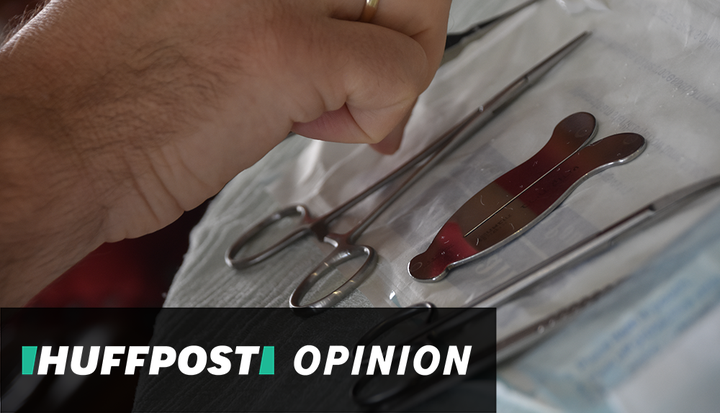
“I really, really, really prefer uncircumcised men,” says one woman.
“Circumcised ones look scarred and mutilated, not an attractive look,” adds another.
″A cut penis is basically a dildo since there are no movable parts,” another person comments.
“I am also a little bit jealous of uncut guys as they luckily get to experience a sensation that I won’t ever be able to experience,” one man says. Another adds: “I feel uncircumcised men have more intense orgasms than I have.”
I didn’t make these comments up. In fact, they are a collection of real-life views on circumcision, recently published by Thought Catalog, Out and the New York Magazine.
The topic has always sparked debate, and while the foreskin might be just a tiny piece of skin, its significance far outstrips its size. But now, the ethics of practising circumcision in the UK are being questioned again, and for good reason. It’s time we address the uneasy coexistence between religious traditions and child protection norms, and decide where we feel the line between the two should be drawn today.
“It’s time to address the uneasy coexistence between religious traditions and child protection norms, and decide where we feel the line between the two should be drawn today.”
Non-therapeutic circumcision, where the retractable fold of skin that covers the head of the penis is surgically removed, is a common practice in Muslim, Jewish and some African communities in the UK. In Jewish families, it occurs when a boy is eight days old in a ceremony known as Bris Milah. Muslims from different parts of the world do it at different ages, according to their specific traditions.
It’s hard to know how many boys are cut each year in the UK as the NHS does not offer non-therapeutic circumcisions, but rough estimates suggest around 30,000.
Jewish families normally use traditional circumcisers, known as mohels. Muslims tend to go to their GPs or circumcision clinics. Almost all ritual circumcisions are conducted on minors on the instruction of their parents.
But the question of consent is one that many campaigners would like to see addressed. According to Chair of Secular Medical Forum, Antony Lempert, “the problem is not to do with circumcision per se. It relates to consent. Autonomy, the right to decide for oneself what happens to one’s own body, is the primary medical ethic and is not being adequately considered when children’s healthy genitals are cut for no medical reason.”
Circumcision is an irreversible process. For men who are unhappy with the way their penis looks and feels as a result of being cut in infancy, there is no way back. The choice their parents made for them will affect a most intimate part of their body and relationships for good.
“For men who are unhappy with the way their penis looks and feels as a result of being cut in infancy, there is no way back. The choice their parents made for them will affect a most intimate part of their body and relationships for good.”
Given the stringent child protection laws in the UK, the permissibility of non-therapeutic circumcision of minors is a legal oddity. But it has not been unchallenged.
There have been several court cases in recent years, including a ruling by the then President of the Family Division of the High Court of England and Wales Lord Justice Munby who declared that male circumcision amounts to “significant harm”.
In 2016, another High Court case prevented circumcision being imposed when parents disagree with one another about the procedure, including in a faith-based context. There have also been criminal prosecutions for negligent circumcisions, some leading to jail terms.
It’s important to remember circumcision is not without its risks. Last December, a boy died after a home circumcision resulted in severe blood loss in a suburb of Rome. His twin brother was reportedly admitted to hospital in a critical condition. In the same month, a doctor in Canada was suspended for five months and banned from circumcising after two of his patients were taken to the emergency room with potentially life-threatening bleeding. One boy had a part of his penis amputated and another’s was so deformed that it needed revision surgery. The doctor had performed 18 circumcisions in 2016 and 17.
It is hard to tell the number of botched circumcisions in Britain, because there is no formal reporting system for it. We sent numerous Freedom of Information requests to hospitals and NHS trusts asking for the number of circumcisions done each year and the number of complications arising from those circumcisions. Their responses confirmed that this data is not systematically collected. Besides, since non-therapeutic circumcision is not supplied by NHS, a lot of circumcisions are carried out outside the system, either privately in GP surgeries, which are not obliged to keep records of the procedure, or by non-medically-trained circumcisers, compounding the risk of complications.
But is it all doom and gloom? What about all the medical advantages of hygienic, circumcised penises we hear?
Advocates of foreskin removal have long argued that it is good for your health, that you would be at a lower risk of contracting Urinary Tract Infection (UTI), penile cancer and Sexually Transmitted Diseases (STDs) if you were circumcised as an infant. However, those claims have come under serious doubt in recent years.
Most of the evidence suggesting a reduced risk of HIV/AIDS comes from trials conducted in sub-Saharan Africa in voluntary, adult circumcisions. Those results do not correspond to the Western European context, where the incidence of HIV/AIDS is significantly lower. STDs are only a risk for sexually active people and they are easily prevented by less invasive methods, such as condoms.
“You have to make a very good argument to put a child at risk of death before doing an operation that they can’t consent to,” Gordon Muir, a prominent urologist in London, told me. “There’s no way back from that.”
The status quo gives parents the right to consent to this procedure on behalf of their child based on religious grounds. This is an exceptional situation; a parent cannot tattoo their child, members of Jehovah’s Witness cannot stop their child from receiving a blood transfusion when their life is at risk.
Parents want to do the best for their children’s physical and spiritual health, there is no doubt about that. Given the risks involved, some Muslim and Jewish parents are starting to question the practice of circumcision, at considerable personal cost.
Ghazal Sadr, an Iranian photographer and mother who now lives in Austria, told me she gave in to tradition seven years ago when her son was an infant and she regrets it even today. “I should not have altered my son’s body… If I had a daughter now, I wouldn’t even have her ears pierced.” She now considers circumcision a case of “violence against children”. “I will be ashamed, sad and full of regret until my last breath for what I did,” she said.
Some Jewish parents have opted for an alternative to Bris Milah, called Brit Shalom, in which the boy is welcomed into the community in a ceremony, but he is not circumcised.
A mother from a Muslim background who lives in Canada told me that she thoroughly researched circumcision and, in the absence of any compelling evidence that it is better for health, decided against having her son circumcised. She asked to remain anonymous.
“When it comes to child protection the law is clear, except in the case of male circumcision. Why is this still viewed as acceptable?”
When it comes to child protection the law is clear, except in the case of male circumcision. Why is this still viewed as acceptable? Perhaps it is time to allow men the opportunity to consent to their own non-therapeutic circumcision when they are old enough to do so.
Ali May is a writer and the associate producer of A Cut Too Far? Male Circumcision, a documentary for BBC1 that airs on Thursday 18 July at 10:35 pm.
Welcome to HuffPost Opinion, a new dedicated space for reliable, expert commentary and analysis on the day’s biggest talking points. Got a unique angle or viewpoint on a news story that will help cut through the noise? We want to hear from you. Read more here.
